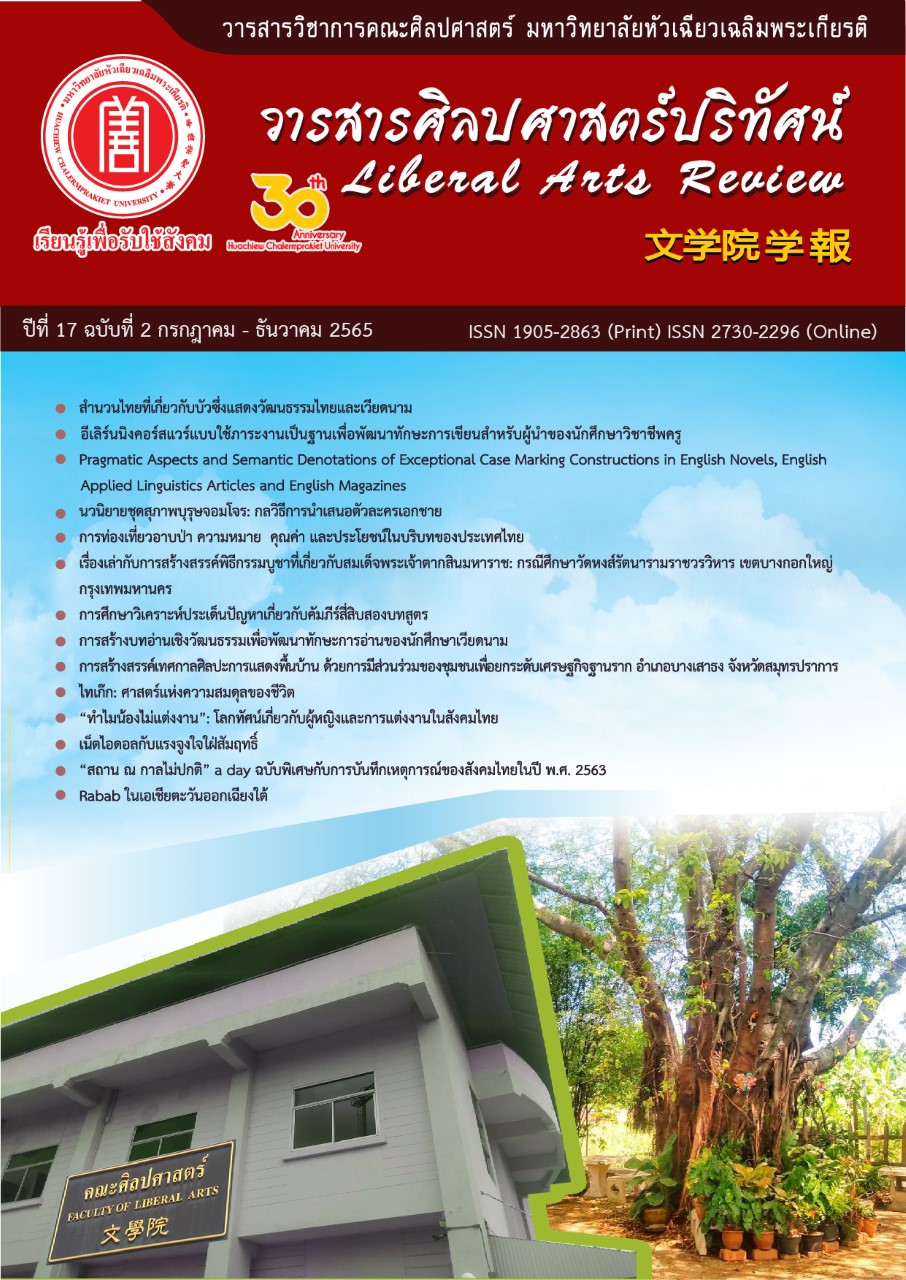A Study and Analysis on Some Questions Related to the Sutra in Forty-two Sections
DOI:
https://doi.org/10.14456/lar.2022.17Keywords:
Gao sengzhuan, Sutra in Forty-two Sections, Chinese Buddhist scriptures, The First Translated ScriptureAbstract
The Sutra in Forty-two Sections (四十二章經) was an essential text related to Buddhist Chinese history during the late Han Dynasty. Some scholars regarded this text as the first Indian Buddhist sutra to be translated into Chinese. Others, however, argue that it was compiled much later by the Chinese, rather than translated by foreign monks during the Han Dynasty.This article aimed to study and analyze the arguments related to the authenticity of the text by both date and content. Evidence from Chinese historical-biographical works such as the Chu sanzangji ji (出三藏記集) and the Gaoseng zhuan (高僧傳), as well as various related pieces of research, were used to examine the text. Research focusing on Chinese Buddhist scripture has really rarely been used in Thai academic circles. The results showed that although it was difficult to trace back to the exact date when the Sutra in Forty-two Sections was translated, corroborating evidence was still able to express that the text already appeared in Chinese history during the late Han dynasty. The content of the original text contained only concepts of the earliest Buddhism. In contrast, the revised texts involved various ideas including Mahayana and Zen Buddhism, as well as Chinese philosophy.
References
พระมหาพงศ์ศักดิ์ ฐานิโย. (2559). การวิจัยเชิงคัมภีร์: กรณีศึกษา “ธัมมจักกัปปวัตนสูตร”. ธรรมธารา วารสารวิชาการทางพระพุทธศาสนา 2(1), 1-33.
พระมหาอานนท์ อานนฺโท. (2564). คัมภีร์ 42 บท ปฐมคัมภีร์พระพุทธศาสนาพากย์จีน. กรุงเทพมหานคร: ศูนย์การแปลคัมภีร์พระพุทธศาสตร์ ไทย-จีน มูลนิธิพุทธรังษี.
เมธี พิทักษ์ธีระธรรม, ปิยาภรณ์ ว่องวรางกูร, และ พรพิมล ศรีหมอก. (2563). ชีวประวัติพระคังเซิงฮุ่ย ในคัมภีร์เกาเซิงจ้วนแปล (1): การอัญเชิญพระบรมสารีริกธาตุของพระคังเซิงฮุ่ย ในรัชสมัยพระเจ้าซุนกวน ยุคสามก๊ก. วารสารพุทธศาสน์ศึกษา จุฬาลงกรณ์มหาวิทยาลัย 27(2), 104-138.
วิไลพร สุจริตธรรมกุล, เมธี พิทักษ์ธีระธรรม, และ ประภากร พนัสดิษฐ์. (2565). รายงานการวิจัยเรื่อง “การถอดความและการศึกษาวิเคราะห์ชีวประวัติพระสมณะ
บนเส้นทางสายไหม: กรณีศึกษาคัมภีร์เกาเซิงจ้วนในหมวดพระผู้แปลคัมภีร์พระพุทธศาสนาตั้งแต่ยุคราชวงศ์ฮั่นถึงราชวงศ์เว่ย.”.
Xu Weijie and Jiang Nannan. (2564). “การเรียนรู้” ในการเรียนการสอนวิชาการแปลไทย-จีน กรณีศึกษาระดับบัณฑิตศึกษา สาขาวิชาการสื่อสารภาษาไทยเป็นภาษาที่สอง มหาวิทยาลัยหัวเฉียวเฉลิมพระเกียรติ. ศิลปศาสตร์ปริทัศน์, 16(2), 18-29.
Chen, Y. (陳垣). (1978). 陳援菴先生來書. 台北: 大乘文化出版社.
Fang, L. (方立天). (2001). 中國佛教簡史. 北京: 宗教文化出版社.
Han, J. (韓劍英). (2008). “宋初孤山智圓《四十二章經》正義.” 佛學研究. 182-190.
Hu, S. (胡適). (1978). “《四十二章經》考. ” 現代佛教學術叢刊. 台北:大乘文化出版社.
Lan, T. (兰天). (2003). “《四十二章經》版本考釋.” 人文雜誌 (05), 151-154.
Liang, Q. (梁启超). (1978). “《四十二章經》辯偽. ” 現代佛教學術叢刊. 台北:大乘文化出版社.
Liang, Q. (梁启超). (2001). 佛学研究十八篇. 上海: 上海古籍出版社.
Lu, C. (呂澂). (1978). “《四十二章經》的抄出年代. ” 現代佛教學術叢刊. 台北:大乘文化出版社.
Maspero, H. (1910). Le songe et l’ambassade de l’empereur Ming, étude critique des sources. BEFEO X. 95–130.
Taiwan great diary. [cited 2022, July 2]. Retrieved from https://twgreatdaily.com/gAlaqW4BMH2_ cNUgyiMk.html.
Tang, Y. (湯用彤). (1997). 漢魏兩晉南北朝佛教史. 北京: 北京大學出版社.
Tang, Y. (湯用彤). (2008). 漢魏兩晉南北朝佛教史. 武漢: 武漢大學出版社.
Taisho Tripitaka Publication Association (Taishō Issaikyō Kankōkai 大正一切經刊行會). (1962). Taishō Revised Tripiṭaka (Taishō Shinshū
Daizōkyō大正新脩大藏經) Vol. 17, 50, 52, 55. Tokyo: Taishō Issaikyō Kankōkai.
Wang, W. (王維誠). (1978). 《四十二章经》道安經錄闕載原因.台北: 大乘文化出版社.
Yang, W. (楊維中). (2016). “《四十二章经》新考.” 佛教研究 (2), 83-89.
Downloads
Published
How to Cite
Issue
Section
License
Copyright (c) 2022 Liberal Arts Review

This work is licensed under a Creative Commons Attribution-NonCommercial-NoDerivatives 4.0 International License.
บทความที่ได้รับการตีพิมพ์เป็นลิขสิทธิ์ของวารสารศิลปศาสตร์วิชาการและวิจัย
ข้อความที่ปรากฏในบทความแต่ละเรื่องในวารสารวิชาการเล่มนี้เป็นความคิดเห็นส่วนตัวของผู้เขียนแต่ละท่านไม่เกี่ยวข้องกับมหาวิทยาลัยหัวเฉียวเฉลิมพระเกียรติ และคณาจารย์ท่านอื่นๆ ในมหาวิทยาลัยฯ แต่อย่างใด ความรับผิดชอบองค์ประกอบทั้งหมดของบทความแต่ละเรื่องเป็นของผู้เขียนแต่ละท่าน หากมีความผิดพลาดใดๆ ผู้เขียนแต่ละท่านจะรับผิดชอบบทความของตนเองแต่ผู้เดียว




